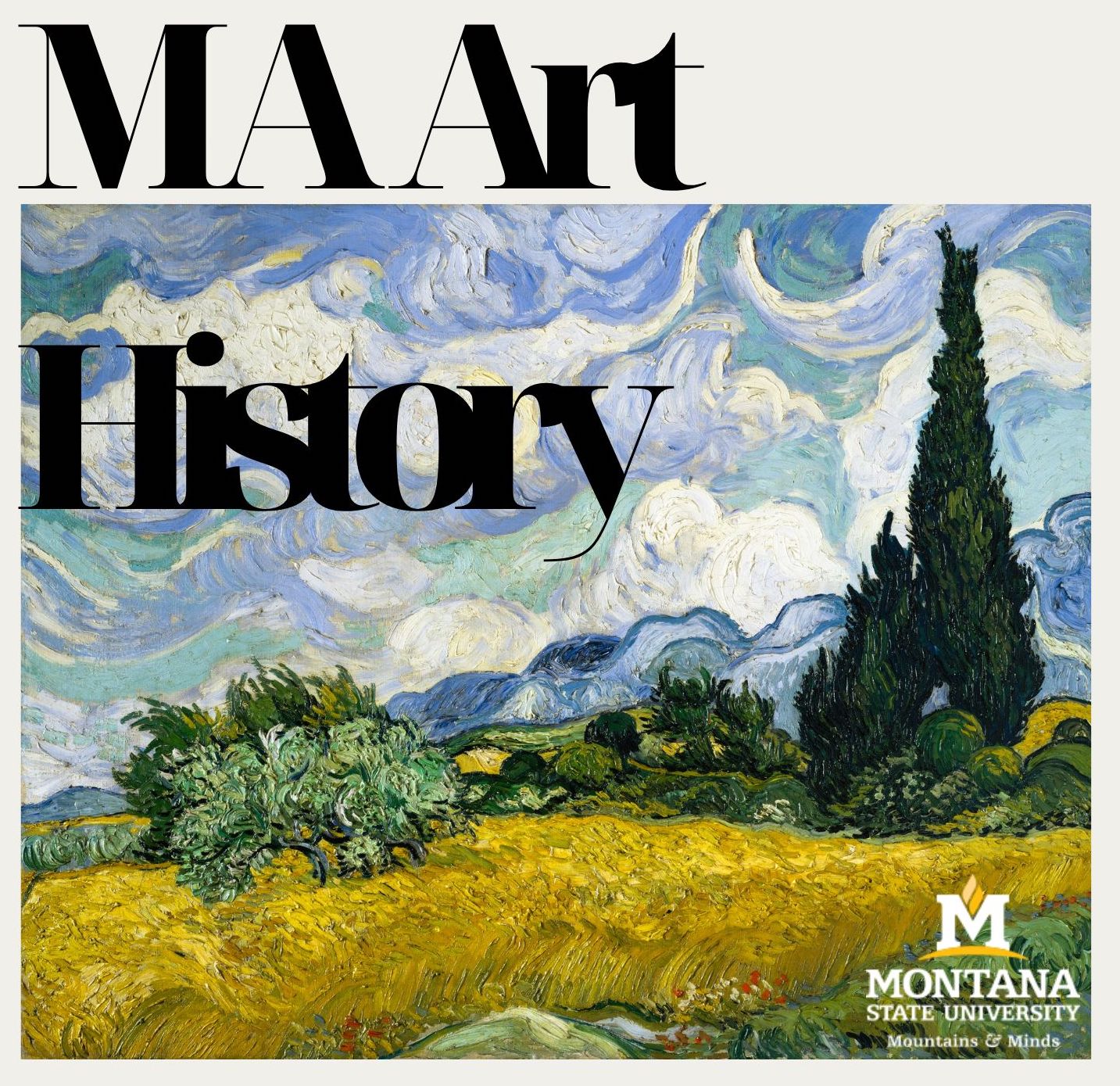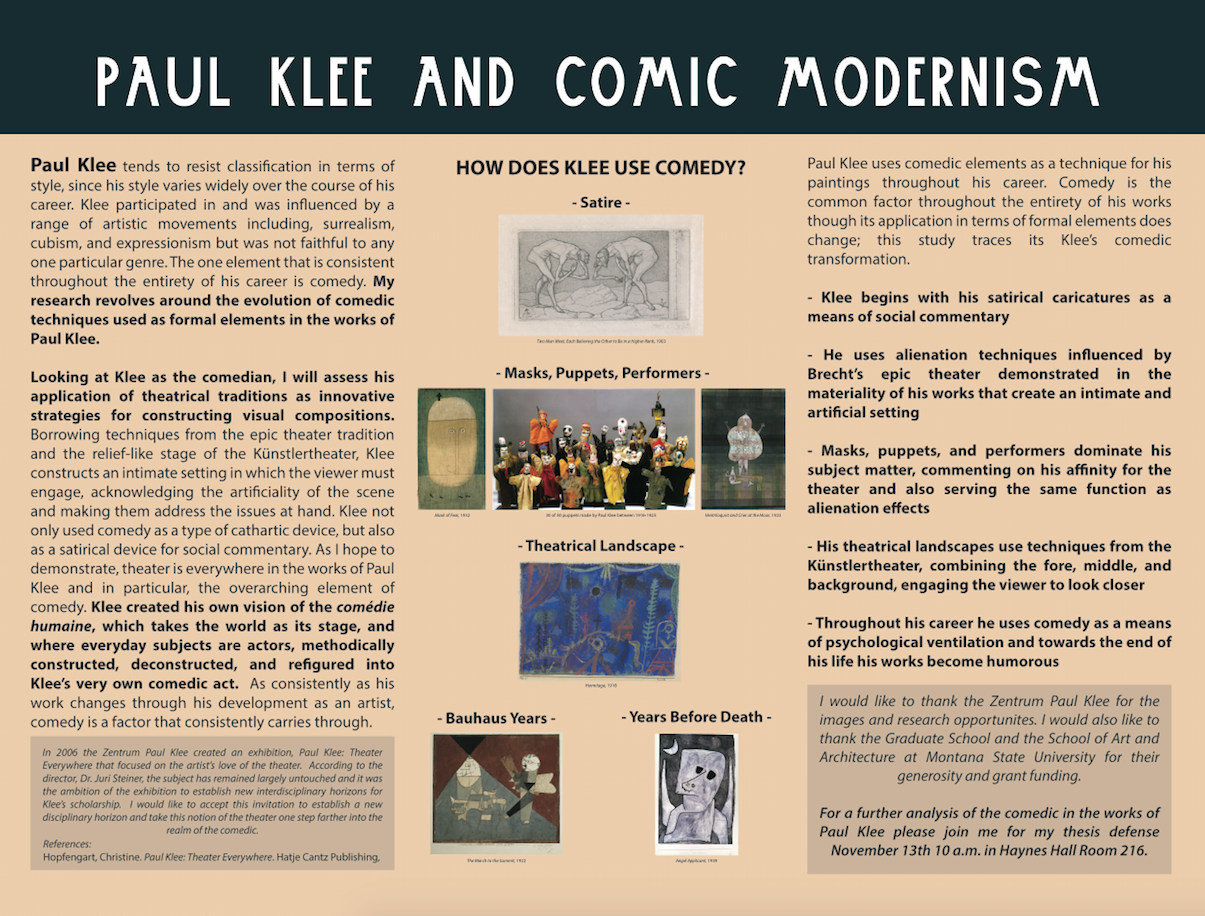MA Program

The MA in Art History
With three full-time, two part-time, and several affiliated faculty, we are currently the only program in the Northern Rocky Mountains able to offer students an innovative curriculum that fosters a critical understanding of the production of art and its environment from the ancient world to the present. While maintaining a commitment to rigorous historical research, we work beyond the traditional boundaries of Art History to explore new perspectives arising from intercultural exchanges, interdisciplinary approaches, and theoretical inquiries. Faculty have extensive experience in field, museum, and archival research, a strong record of scholarly publications, and strong backgrounds in theory and methods. We prepare graduate students for careers in academic instruction, art administration, and art criticism.
Students may pursue studies in the following areas:
- Ancient Greek and Roman Civilization
- Medieval Western Europe
- Renaissance Italy and Northern Europe
- Baroque Italy and Northern Europe
- Rococo and Neoclassical France and Britain
- Modern Europe and the United States
- Contemporary Europe and the United States
- Ancient to Contemporary China
- Ancient Meso-America
- Colonial to Modern America
- Decorative Arts
- Early Modern Print Culture
- Museum Studies
- Critical Theory and Methods
The program is supported by the Art History Graduate Offices, the Visual Resources Collection, the Helen E. Copeland Gallery, the Roland R. Renne Library, and the Museum of the Rockies. Students participate regularly in departmental symposia with the expectation that they will become informed and effective writers and speakers.
We welcome inquiries and applications from students who have an academic background in art history or a broad spectrum of the humanities and social sciences. Candidates should have the motivation to learn to read a foreign language, to employ analytical structures, and to make timely progress through the two-year program. At the time of application, all graduate MA candidates are expected to have completed at least 30 units of undergraduate instruction in art history or a related field in the humanities, together with two years of foreign language.
If you have any questions please contact our MA coordinator, Melissa Ragain, at melissa.ragain@montana.edu
Art History Faculty
- Todd Larkin, Professor Art History – Baroque to Impressionism
- Regina Gee, Professor Art History – Greek and Roman Antiquity
- Melissa Ragain, Associate Professor Art History – Modern and Contemporary, Art Criticism
Degree Requirments
Program Requirements
| Courses | Title | Credits |
| ARTH 501 | Pedagogy and Professionalism | 2 |
| ARTH 506 |
Methods and Critical Theory |
3 |
| Five Required Core Courses (3 graduate art history seminars & 2 400-level art history lectures at graduate level) | 15 | |
| Two Elective Courses (2 graduate seminars at 500 -level outside the department) | 6 | |
| ARTH 590 | Master's Thesis | 6 |
| Total Credits |
32 |
Curriculm by Semester
1st Semester: (8 credits)
- GTA
- Coursework
- Pedagogy & Professionalism (2cr)
- Methods & Critical Theory (3cr)
- 1 x 500-level ARTH course (3cr)
2nd Semester: (9 credits)
- GTA – with in-class observation coordinated by Graduate Director (Dr. Melissa Ragain)
- Coursework
- 1 x 400-level ARTH course (3cr)
- 1 x 500-level ARTH thematic seminar (3cr)
- 1x 500-level graduate course in CLS/CAA (3cr)
- Choose your committee chair from the three ARTH faculty
- Research Presentation as part of ARTH spring symposium
- Written pre-thesis plan submitted to your chair and copied to both other ARTH faculty
- Apply for any summer or 2nd year research funds through CAA, the Graduate School, or outside sources
SUMMER
- Gather research resources for your MA thesis from museums, archives, libraries, interviews.
- Plan and submit any conference proposals for spring semester. These are often due in late summer or early fall.
- Take any other foreign language you need
3rd Semester (9 credits)
- September: Pre-thesis presentation delivered to ARTH Faculty
- GTA (optional)
- Coursework
- 1x 500-level graduate course in CLS/CAA (3cr)
- 1 x ARTZ Graduate Caucus OR 500-level ARTH thematic seminar (3cr)
- 1x 400-level ARTH course (3cr)
- By the end of semester: Full thesis outline your Committee Chair
- Over break: Request letters of recommendation for summer fellowships/internships
4th Semester (6 credits)
- January: Meet with your Chair to determine bi-weekly chapter submission schedule
- GTA (optional)
- Coursework
- 1 x Master’s Thesis (6cr)
- Draft thesis submitted to Committee Chair
- Revised Thesis submitted Full Committee in HARD COPY
- A minimum of 1 week before your filing date: Thesis Presentation and Defense
- File with Graduate School
How to Apply
The M.A. Program welcomes applications from all those interested in seeking an advanced degree in Art History. No more than eight students are accepted each year to a thirty-two unit program that emphasizes focused study of cultural production from ancient times to the present and interdisciplinary connections with collateral departments in the Colleges of Arts & Architecture and Letters and Sciences. Art History faculty meet once a year to read and assess applications, with a particular sensitivity to the students’ work and professional goals.
Application
The application consists of a standardized form and processing fee required by the university as well as individual writings and documents required by the department.
- You can complete the standardized form on line; please go the Graduate School homepage at https://www.applyweb.com/msug/
- A non-refundable application fee of $70 is required for all applicants.
In addition to completing the application and paying the application fee, candidates for admission to the Art History M.A. Program must submit electronically the following materials
- A letter of intent
- Two writing samples
- Unoffical undergraduate transcripts (Official transcripts will be requested for formal admission)
- Two letters of recommendation
International applicants may also include an unofficial English proficiency exam score report and if available, a completed and signed Financial Certificate; please see the International Admissions Graduate webpage at http://www.montana.edu/gradschool/policy/admissions_intl.html for complete details.
Candidates are responsible for ensuring that all requisite application materials are submitted by February 15 for fall admission.
Guidelines: The faculty consider the letter of intent and the writing samples to be among the most important parts of the application. The letter should describe your main areas of research interest, including the region, period or style of the art to be researched, as well as potential thematic or topical concerns of interest, also include describe what skills you have acquired that will aid you in studying this field. As well as outline the skills or knowledge you will need to acquire as a graduate student in order to pursue your research topic. This may include resources you will need access to effectively conduct research in your chosen topic. Please describe your ideal career outcomes after acquiring a Master's Degree from our program.
The writing samples should be a substantial essays, and at least one should be a seminar paper or senior thesis, that demonstrates the candidate’s potential for advanced work in the discipline.
Letters of recommendation are most helpful when they speak of the applicant’s academic and professional achievements in Art History or related fields such as History, Literature, Foreign Language, and potential for graduate study. Letters from professors or curators are generally far more effective than those from counselors, employers, or friends.
Funding
Many graduate students receive teaching assistantships and fee waivers to help defray the cost of graduate study. However, financial aid is available to graduate students who show evidence of financial need. While such assistance may take various forms, most graduate students receive aid through loans or the work/study program.
For further information, consult the Graduate School on-line at http://www.montana.edu/gradschool/ and contact the Financial Aid Office (located on the lower floor of the Strand Union Building, MSU) at (406)994-2845.
Assistantships are awarded annually on a competitive basis; all interested students, including current TAs, must apply for the new academic year. Teaching assistantships are awarded in the spring for the following academic year. Teaching assistantships carry with them tuition waivers. Tuition waivers cover tuition only. Fees such as registration, building, computer equipment, insurance, etc. are not covered by the waiver.
In addition to teaching assistantships, advanced graduate students may be offered the opportunity to design and teach a summer course.
NOTE: If you are not a Montana resident, you may be eligible for 150% of in-state tuition under the WRGP-WICHE program. The receipt of a WRGP tuition change is not automatic and is subject to an additional review by the Graduate School and the College of Arts & Architecture. If you would like to be nominated to receive one of these limited spots, please request consideration in the application on the bottom of page 7 (check box). Then on page 8 upload a brief memo explaining why you feel you should be nominated. If awarded, you will be notified at the time of admission.
Professional Opportunities
Student should seek out a variety of the professional experience available to them. Students are encouraged to pursue internships or independent projects with:
- The Emerson Cultural Center, http://www.theemerson.org/
- The Museum of the Rockies, www.museumoftherockies.org
- The Danforth Art Museum, https://thedanforth.org/
- The Yellowstone Art Musuem, https://www.artmuseum.org/
- Tinworks Art, https://www.tinworksart.org/
- Bozeman Art Museum, https://bozemanartmuseum.org/
Recent Awards

MA Graduate Student Jesine Munson placed first in the category of Architecture, Arts, & Humanities for the 2015 Graduate Student Summit Research Rendezvous Poster Session with her poster entitled "Paul Klee and Comic Modernism." She will receive a $250 travel grant towards participation in a domestic professional conference and plans on attending our annual CAA conference in Washington D.C. and has also applied to speak at Boston University Graduate Symposium on the History of Art and Architecture. Jesine is currently an adjunct teacher for the School of Art and a doctoral candidate in the American Studies program at MSU.







